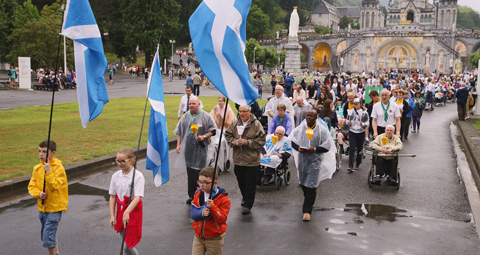February 3 | ![]() 0 COMMENTS
0 COMMENTS ![]() print
print

A journey through the history of pilgrimage
By Dr Harry Schnitker
Lord, may this sacrifice, which has made our peace with you, advance the peace and salvation of all the world. Strengthen in faith and love your pilgrim Church on earth; your servant, Pope [name], our Bishop [name of local bishop], and all the bishops, with the clergy and the entire people your Son has gained for you. Father, hear the prayers of the family you have gathered here before you. In mercy and love unite all your children wherever they may be.”
As one would expect, this passage from the third Eucharistic Prayer contains within it a number of crucial theological and ecclesial truths. It emphasises the sacrificial nature of the Eucharist, the unity of the Church, the source of that unity, and the scattered nature of the Church.
Above and beyond that, it touches upon an essential truth about the Church and the lives of its members. The Church, both in the lives of its members and as an institution, is a pilgrim Church whilst on earth. The earth is a temporary reality, both in time and in space, through which the Church moves.
That moving, that sense of being in motion, is crucial: Salvific History teaches us that we are located in time. That time is determined by the Incarnation, and has since moved towards an End of Times.
This may be some time away for the institution of the Church, but for its individual members the brevity of life is all too real and immediate. Moving through time can be distinctly uncomfortable.
Most people react to it by creating permanent reminders of particular moments in time. Think, for example, of the memorial benches inscribed with names of a beloved deceased relative in city parks. Or that church where grandparents and parents were Baptised, made their first Holy Communion, were married and perhaps even buried.
What is true about individual places of commemoration, what the French call les lieux de mémoire, is also true of collective ones. For centuries upon centuries, Christians have recalled specific moments in Salvific History in particular locations. Most obviously, this has been the case in the Holy Land and those places associated with the ministry of Christ.
Prominently, too, have been the holy sites of Rome, the heart of the Church, and most especially the tomb of St Peter on the Vatican Hill. From the font flowed the inspiration for more localised centres of memory; places such as Santiago de Compostella (for the Apostle St James) and Saint Andrews became associated with the immediate disciples of Christ.
Gradually, the events or people commemorated became more localised still. St Martin in Tours, St Agnes in Prague, St Thomas in Canterbury or St Margaret in Dunfermline all had a fairly wide, but not a universal appeal. However, St Madoes in the Carse of Gowrie, or St Dymphna in Gheel, or St Corbinian in Bavaria were all of strictly local importance. Besides people, certain places became sacred for their own sake: the myriad of holy wells that mark every corner of Europe are, perhaps, the best example.
To such places of memory people began to travel, first and foremost because of their piety, but also and sometimes indistinguishably, for more worldly reasons or out of sheer curiosity. This began rather late in time: before the early fourth century there is little evidence for any form of religious travel to places sanctified by association with holy men or women. This is often ascribed to an indifference to such activity amongst the early Christians. Indeed, to Protestants of the 16th century, wishing to return to the early Church, this disqualified pilgrimage as a legitimate religious activity.
However, we simply do not know whether or not there were pilgrimages at this time. What we do know is that relics of the martyrs were collected from the early second century onwards, and this presupposes that some at least journeyed to see these relics.
Perhaps there was a more worldly, less theological reason for the lack of pilgrims on the roads of the Roman Empire. Christians were at best tolerated, at worst killed—not the climate for extended religious journeying. From as soon as the Empire embraced Christianity in the decades after 310, pilgrims begin to appear on its roads, offering some evidence for the persecution argument.
Once pilgrimage became possible it grew exponentially. It centred first and foremost on Jerusalem, the site of Calvary and the Resurrection, as well as the Via Dolorosa, the room of the Last Supper and other significant places connected with Jesus’ last days.
However, other places in the Holy Land, such as Bethlehem or Nazareth, the Sea of Galilee and the River Jordan, all soon attracted pilgrims. They fanned out into Anatolia, to places such as Ephesus, connected with the Virgin Mary, and to Rome, before more localised pilgrimages arose. By the High Middle Ages, Europe was covered in a dense network of pilgrimage roads, connecting its myriad of pilgrimage centres.
It is not too fanciful to argue that pilgrimages assisted greatly in creating Europe. Towns grew up around sites of pilgrimage, bridges were built across rivers, ferries established over estuaries, harbours created, hostels erected. A veritable infrastructure catered for the many thousands who journeyed to the holy places.
In Scotland, this is still very much in evidence around both Saint Andrews and Dunfermline, and, to a lesser extent, around Whithorn and Tain. Pilgrims were a crucial source of income for many, and pilgrimage could be, but were not always, expensive: in 1352, for example, an English pilgrim paid £20 for a journey to Mount Sinai, in an age when £5 was an annual salary.
Numbers were staggering. In 1435, for example, no fewer than 65 ships left England for Compostella alone. How many pilgrims these carried is difficult to decide, but there will have been at least 100 per vessel, or 6,500 pilgrims for this shrine alone. Translated into contemporary numbers per population, we are talking about 250,000 people leaving England for Compostella in modern terms. And that was one shrine, and pilgrims from but one country to that shrine.
Unlike what one is often led to believe, pilgrimage did not die with the Reformation. It did tail off, and would only revive in larger numbers with the remarkable Marian apparitions of the 19th century.
In the past two centuries, pilgrimage has once again become a hallmark of Catholicism, a powerful expression of both individual but also of communal Faith. Numbers are mindboggling. Lourdes receives around six million visitors every year, leaving the rest of Europe’s pilgrimage places except Rome trailing.
However, other centres are also displaying striking visitor numbers. Our Lady of Czestochowa, Poland’s national shrine, has around 100,000 visitors in August alone. Medjugorje can count on some 330,000 communicants every year. Bethlehem has 5,000 on Christmas Day.
Pilgrimage is also increasing in importance and popularity. In 1986, only 2,500 pilgrims walked the Camino, the route to Santiago de Compostella; in 2016 the number had reached 280,000!
Rome, during the Jubilee Year of Mercy, had 3,900,000 pilgrims who came to see the Holy Father. This compares favourably with the Hajj, the most important pilgrimage site of Islam in Mecca, which attracts 1,800,000. Many Catholics, including many in Scotland, undertake regular pilgrimages, many more occasional ones.
All this warrants a closer look at pilgrimage in the SCO, and so this series will focus on all elements of pilgrimage: historical, cultural, theological and social. It will examine individual places of pilgrimage, and will present eyewitness accounts of those who have undertaken pilgrimages, past and present.











